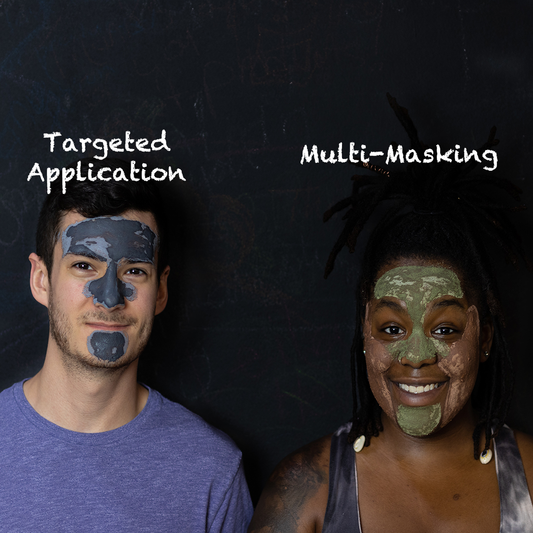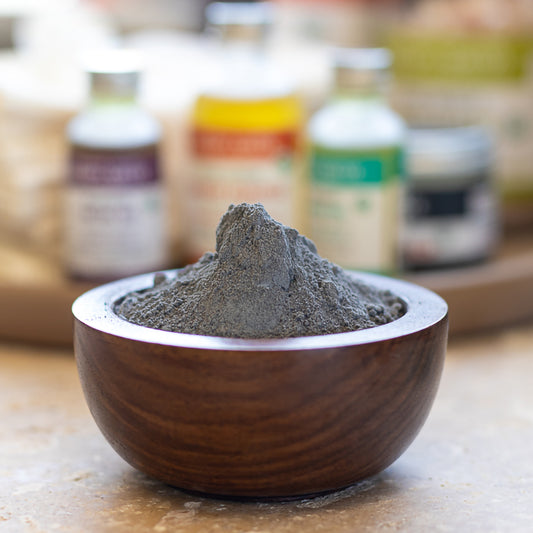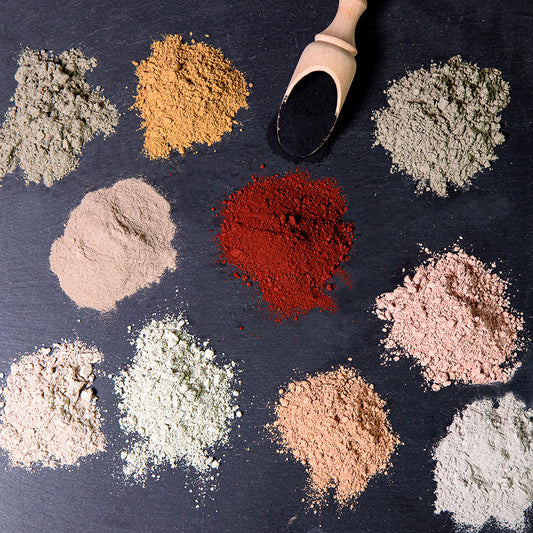How To Use Natural Clay Face Masks
Clay facial masks are an easy and inexpensive way for both men and women to pamper themselves and invigorate their skin.
 The topical use of clay as a beauty ritual traces back to the earliest civilizations. From Ancient Egypt to Ancient Rome and even during the Renaissance, men and women used the medicinal properties of clay to achieve a brighter, smoother, and more youthful complexion.
The topical use of clay as a beauty ritual traces back to the earliest civilizations. From Ancient Egypt to Ancient Rome and even during the Renaissance, men and women used the medicinal properties of clay to achieve a brighter, smoother, and more youthful complexion.
Clay Face Masks can work wonders for your skin. The simple natural ingredients can help exfoliate and soften skin, draw out impurities, minimize pores, and remove excess surface oil.
Quick Tip: Mix up a tiny bit of your clay mask and use it as a spot treatment on active acne.
Creating an application technique that works for your skin will get you one step closer to a beautiful complexion.
Gather the Clay Mask Ingredients/Equipment
- small non-metal bowl
- small non-metal spoon
- dry clay powder
- water
- facial clay mask applicator brush
- natural cotton face cloth
- soft towel
Check out our Clay Facial Masks page for accessories.
Be sure that your equipment, including your hands, is clean!
Mixing The Facial Clay Mask
 Step 1: Start with approx 1/2 to 1 Tablespoon of clay in a clay mask bowl or any small non-metal bowl.
Step 1: Start with approx 1/2 to 1 Tablespoon of clay in a clay mask bowl or any small non-metal bowl.
Step 2: Slowly add 1/4 teaspoon of room temperature or warm water and mix with a non-metal spoon.
Step 3: Continue adding small amounts of water and mixing until a creamy mud-like consistency is reached.
Important note: When mixing clay with water, it is recommended that you do NOT use metal. So, stick to wood, glass or plastic mixing bowls and spoons. The quick and simple reason -- when clay comes into contact with water the clay is "activated" and contains negatively charged ions which may be affected by ions present in metal utensils.
 Some clays need more water and some need less, so always begin with just a little water and continue to check the consistency.
Some clays need more water and some need less, so always begin with just a little water and continue to check the consistency.
Be sure to mix well to a smooth clay paste.
Applying the Clay Mask
 Step 1: Begin with a clean, dry face free of make-up, moisturizers, etc. (*See "More Info" below)
Step 1: Begin with a clean, dry face free of make-up, moisturizers, etc. (*See "More Info" below)
Step 2: Using a face mask brush or a flat foundation brush, apply the mask to your face (and neck if desired).
You can apply using any technique that you like. Typically, you only need to apply one even layer to your skin. A super-thick layer will not result in a more effective mask.
I usually apply a thin first layer and then apply a second thin layer so the mask is about 1/8″ thick--just my preference.
 If you have combination skin, read our blog about Targeted Application and Multi-Masking
If you have combination skin, read our blog about Targeted Application and Multi-Masking
Step 3: Allow mask to dry for 5-10 minutes. Drying times vary depending on the clay and your skin type.
For oily skin or a deep cleanse, allow the mask to dry almost completely and then remove--leaving the mask on longer does not add anything beneficial to the treatment and may cause increased redness.
 The drying phase is when the clay draws moisture from the surface of the skin.
The drying phase is when the clay draws moisture from the surface of the skin.
Thus for sensitive or dry skin or a more gentle cleanse, allow the mask to only dry around the edges of the face and nose and then remove (about 5 minutes).
Removing the Facial Mask
Step 1: I like to remove a clay mask with warm water and my fingers.
 To re-hydrate the mask a bit for easier removal, you can dampen a natural cotton facecloth a with warm water and hold it to the face before removal.
To re-hydrate the mask a bit for easier removal, you can dampen a natural cotton facecloth a with warm water and hold it to the face before removal.
Using gentle circular motions with fingers helps to stimulate circulation, polish your skin and provide an exfoliating action as the mask is removed. You may also use a face cloth to remove the mask.
As the clay dries you will feel a pulling and tightening sensation on your skin.
However, if your skin ever burns, hurts, or generally feels uncomfortable, wash the mask off immediately.
If you choose to use a clay mask on your neck and décolletage, please note that the skin on your neck and chest is thinner, more sensitive, and has fewer oil glands. If you have sensitive skin you may experience redness or irritation which may take a while to recover.
 Step 2: Gently pat face dry completely with a soft towel.
Step 2: Gently pat face dry completely with a soft towel.
Clay helps increase circulation. As a result, you may experience a mild temporary redness for up to 30 minutes.
After application of a clay mask, you will feel a tightening effect and the skin may even feel a bit itchy at first.
 Step 3: Moisturize! Follow-up with a facial oil or moisturizer
Step 3: Moisturize! Follow-up with a facial oil or moisturizer
Step 4: Enjoy your super smooth and beautifully fresh skin!
You don’t have to reserve clay facial masks for special occasions! You are always special!
Clay Face Masks can be a versatile addition to any skincare regimen. We love our powder clay masks because, unlike the already prepared gel and cream masks, powder masks can be easily customized with extra mix-in ingredients* to provide your complexion with exactly what it needs as the seasons or your facial skin changes over time. The powder formula also stays fresh without preservatives.
*Learn More Blog: Clay Facial Mask Recipes & The Science Behind Them
More Info About Clay Facial Masks
Should I wash my face (or shower) before using a facial clay mask?
Whether or not to wash your face before using a facial clay mask is up for debate and you are likely to find a lot of conflicting information online.
To Wash: There are those who say you should "absolutely" wash your face in to order remove the surface layer of dirt, oil, and makeup.
This surface grime can hinder the ability of the active clay ingredients to get into the pores and do their job.
Some also believe that when you apply a clay mask to unclean skin, you may be trapping all sorts of dirt, bacteria, and other impurities, possibly driving them deeper into the facial pores.
But we are not talking about an intense or exfoliating scrub.
 You simply need a gentle washing with a bar of mild natural soap to remove the excess oil, dirt, and traces of makeup.
You simply need a gentle washing with a bar of mild natural soap to remove the excess oil, dirt, and traces of makeup.
Not To Wash: Some believe that washing before applying a clay mask may be too drying especially for those with dry or sensitive skin types.
After washing your pores are open and anything you apply will be more rapidly absorbed which may cause more irritation with sensitive skin. If you think about it, moisturizing is best done immediately after washing for that same reason.
In my opinion, the answer to this question really depends on the type or purpose of the mask you are using and your skin type. For example, if you are using a deep cleansing mask for oily or problem combination skin, a fresh wash with warm water can help open pores which prepares the skin for a deeper cleansing experience.
Basically, the same logic holds true for whether or not to shower before or after a clay mask treatment.
Showering Before: Again this method works well with deep cleansing masks for oily and combination skin. The warm water and steam from the shower open your pores.
Showering After: If you have drier skin, you want to apply the mask before taking a shower. The warm shower will actually help seal in the moisture.
To be honest, I do not wash my face before applying a clay mask. However, I do not wear make-up or use heavy creams and basically, my face simply gets dirty from normal exposure to everyday dirt and pollutants. I have aging dryish skin and washing before applying the face mask makes my skin feel too dry afterward. I just use the clay mask and then after rinsing, I moisturize.
Now, all that being said, if your skin is oily, your face feels quite dirty, or is loaded with make-up you may choose to do a quick wash before applying the clay.
How Often Can I Use a Clay Mask?
There is no totally correct answer because as with any skincare treatment, it is most important to notice how your own skin reacts to the treatment.
 Since clay masks can have a strong absorption effect on the skin, it is usually recommended that you use a clay mask 1-2 times per week.
Since clay masks can have a strong absorption effect on the skin, it is usually recommended that you use a clay mask 1-2 times per week.
Remember that more is not always better.
While the major factor in determining how frequently you should apply a clay mask is your skin type, the type of mask should also be considered.
Other factors that can affect how often you should use a clay face mask are the weather and time of year.
Your skin type may actually change with the seasons. For some, the Summer sun is very drying. However, for others, the Winter dry heat can be worse.
Skin can fall into a wide range of categories but in general, it is usually considered one of these four types: oily or acne-prone, normal, combination, or dry or mature.
Oily or Acne-Prone Skin is often more resilient and may tolerate a more drawing mask and a more aggressive regimen of clay masking. Begin slowly, but you can probably use a facial mask 2 to 3 times per week. However, do not use 3 masks your first week, begin slowly and build up to it.
Dry or Mature Skin is more sensitive. I would recommend using a gentle mask once a week.
Combination Skin may require a bit more experimentation. Since you basically have two skin types on your face you may need to use more than one mask.
I recommend reading our blog about Targeted Application and Multi-Masking
Normal Skin is a tough one. I am not sure I have ever met anyone with a "normal" skin type.
Begin by using a gentle mask, like those containing kaolin clay, once a week.
Then you can then increase the number of times per week to 2 or 3. As you switch to different masks remember that a more drawing clay may be more irritating--so go slowly!
When is the Best Time to Apply a Clay Mask?
Applying a clay mask facial on a quiet evening before bed is a nice way to relax and unwind. It also helps cleanse the impurities that have built-up on your skin during the day and allows your skin to rejuvenate during the night. Also since clay masks may cause some temporary redness, an evening application will give the skin time to refresh itself.
It is not a good idea to take the time to enjoy a clay mask facial and then immediately pile on lots of makeup.
If you choose to do a mask in the morning, allow your skin a rest for at least an hour before applying makeup.
Little Tip: Be sure you are comfortable with the way your skin reacts to a mask. Do NOT use a new face mask right before you are planning to go out.
**If you are concerned about skin sensitivity do a small skin patch test.

Clay Facial Mask Recipes & The Science Behind Them
Multi-Masking and Targeted Application For Combination Facial Skin
Creating A Facial Skin Care Routine








